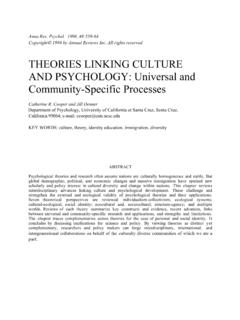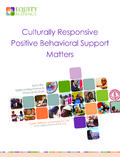Transcription of Assessing mental health needs of rural schools in South ...
1 Research in Higher Education Journal mental health needs of rural schools , Page 1 Assessing mental health needs of rural schools in South Texas: Counselors perspectives Steve F. Bain Texas A&M University-Kingsville Breeze Rueda Texas A&M University-Kingsville Jennifer Mata-Villarreal Texas A&M University-Kingsville Marie-Anne Mundy Texas A&M University-Kingsville ABSTRACT Texas continues to fall short of the necessary mental health resources for those communities and populations in rural counties. The purpose of this article was to review the mental health resource needs of rural schools in South Texas. The study focused primarily on the perspectives of the school counselors in the identified districts. Funded by a grant from the South Texas Expansion Program for Hispanic Graduate Students (STEP-HG) Project received by Texas A&M University-Kingsville, the authors conducted a survey of school counselors in the South Texas and Coastal Bend area designed to assess the availability of mental health resources in these rural districts.
2 This article provides an analysis of those findings and a discussion of key issues surrounding the need for mental health resources. The findings will be used to determine a potential strategy for bolstering these resources in underserved rural communities. Key words: rural mental health , rural school districts, school counselors, mental health resources, rural populations, South Texas, Coastal Bend. This research project was supported by the South Texas Expansion Program for Hispanic Graduate Students (STEP-HG), funded by the Department of Education - The Office of Postsecondary Education Promoting Post-baccalaureate Opportunities for Hispanic Americans (PPOHA) Program. Grant no. PO31M105058. INTRODUCTION Research in Higher Education Journal mental health needs of rural schools , Page 2 mental health issues and lack of resources are common worldwide. Depression, alcohol use, bipolar disorder, schizophrenia, and obsessive-compulsive disorder have been identified as being in the top ten leading causes of disability (The Global Burden of Disease, 2000).
3 Kessler and Berglund (2005) stated that one out of two individuals may be affected by mental illness during their lives. Braichet, Dayrit, and Dolea (2010) stated half of the world s population resides in rural areas but they are only served by less than a quarter of all doctors and less than a third of all nurses" ( p. 322). According to the World health Organization (2011), people with mental health disorders across the globe are often subjected to social isolation, poor quality of life and increased mortality (p. 1). Providing services to these global populations has been plagued by obstacles such as attracting mental health professionals, political hindrances, lack of funds, and lack of priority. The World health Resource Book on mental health , Human Rights and Legislation (2005) serves as a guide for countries seeking to enact legislation geared toward equality for the mentally ill.
4 However, currently, there is no universal mental health legislation that protects or enhances the lives of those afflicted with mental health conditions. In the United States, the rural mental health crisis mirrors the global mental health calamity on a microscopic echelon. Healthcare in America has transformed from necessity to industry. health insurance coverage for mental health services consumes 9% of health expenditures excluding the 26% in federal spending for the uninsured (Gustafson, Hudson & Preston, 2009). According to the Affordable Healthcare Act, passed on March 23, 2010, 95% of the population would be insured; Americans with pre-existing disabilities and/or behavioral health conditions would no longer be denied health insurance (Substance Abuse and mental health Service Administration, 2010). Despite this advancement in health coverage, rural communities may continue to encounter barriers to receiving adequate mental health services.
5 Moreover, 20% of families report having at least one member with mental health needs (National Alliance on mental Illness [NAMI], 2009). The availability of mental health treatment ( facilities, professionals) and supportive technological shortfalls remain unresolved, particularly in rural areas. Approximately 32% of the American population is affected by mental disorders during a one-year period. About 50% of people may experience a mental illness in their lifetime. Of those, 22% can be classified as having a serious mental illness and another 37% having a moderate mental illness. For those people with mental disorders, almost half may present co-occurring disorders (Kessler, Chui, Demler, & Walters, 2005). It may be argued that America s youngest generation is seriously threatened by the lack of adequate mental health services. Although there is a significant amount of American children struggling with psychological issues, only approximately one-quarter to one-third of these children are able to receive mental health services to meet their needs ( Department of health and Human Services, 2001).
6 In many parts of the United States there is a significant shortage of practitioners who are qualified to provide effective treatments (Starr, Campbell, & Herrick, 2002). mental health services can be considered a shortage when a ratio of 1:30,000 is exceeded. In the United States, 37% of the population live in areas where there are less than 30, 000 residents (Hauenstein, Petterson, Merwin, Rovnyak, & Heise, 2006). In 1990, the census identified 3,075 counties in the United States and 55% did not have access to psychiatrists, psychologists, family therapy or clinically trained social workers (Hauenstein et al., 2006). According to these numbers, it is likely that many areas are not receiving mental health services and there may not be a single Research in Higher Education Journal mental health needs of rural schools , Page 3 mental health expert within a 100 mile radius for almost 20% of all counties (Hauenstein et al.)
7 , 2006). In 2000, the Department of Agriculture, Economic Research Service stated that rural areas in the United States contain about 20% of the population and consist of 80% of land. These proportions make rural and urban areas different in many ways. Sawyer, Gale, and Lambert (2006) declared there are three relevant barriers associated with the delivery and utilization of mental health services which are availability, accessibility, and acceptability. In addition, three factors are considered to contribute to the accessibility of service: knowledge, transportation, and financing (The President s New Freedom Commission on mental health , 2004). Mulder and Lambert (2006) indicated that perceptions of mental health needs are a vital factor in accessing services. Therefore, knowledge about individual mental needs , options, and resources available is an essential element of accessibility ( Department of health and Human Services, 2005).
8 rural communities are characterized by minimal use of preventative and screening services and fewer visits with physicians (DeLeon, Wakefield, & Hagglund, 2003). In addition, rural youth struggling with mental health problems present similar levels of functional impairment as non- rural youth who frequently receive early screening, diagnosing, and treatment. Youth in rural areas need equity in access to mental health services (Walrath, Miech, Holden, Manteuffel, Santiago, & Leaf, 2003). Although mental health services are limited in rural areas, the prevalence of mental health problems is not. Substance abuse and suicide rates among adults and children are also higher in rural areas ( Department of health and Human Services, 2005). The rural communities heavy reliance on general practitioners for all healthcare needs is a long-standing issue. Bailey (2009) found that mental health conditions may be misdiagnosed or unidentified.
9 Gustafson et al. (2009) declared " mental illness is common in both urban and rural areas, affecting approximately 25% of the United States population in a given year" (p. 1). In contrast to their urban counterparts, the mental health epidemic is worse in rural areas with rates of depression and suicide far exceeding population ratio (Gustafson et al., 2009). Texas is the second most populous state in the United States and contains the highest uninsured population which is almost 25%. Texas has isolated rural and frontier areas and it is located in the hurricane-prone Gulf region. All of these factors have a great influence on the need for mental health services. According to the National Alliance on mental Illness (2009), the mental health care system of Texas was assigned a D which ranked the state below the national average. High amounts of uninsured people and poor funding for local mental health services were some of the main concerns that reflected this low score.
10 This same report found that the mental health care system in Texas is deteriorating (NAMI, 2009). According to the Center for mental health Services (CMHS, 2008), there are an estimated 846,589 adults with a serious mental illness in Texas and only 250,000 individuals have received services from the State mental health Authority (SMHA). To be able to obtain therapeutic services in Texas, many individuals must meet the federal definition of serious mental illness which includes schizophrenia, bipolar, or major depression for adults. However, only 64% of SMHA clients meet these criteria (CMHS, 2008). Texas annual SMHA expenditures were approximately $800 million for 2010, providing mental health services to ten out of every 1,000 individuals. These rates fell below the national average of approximately 20 per 1,000 people served by the SMHA nationwide (CMHS, 2008). Texas state mental health per capita spending was approximately $22 for community-based services, ranking Texas in the bottom 20% of states (CMHS, 2008).















